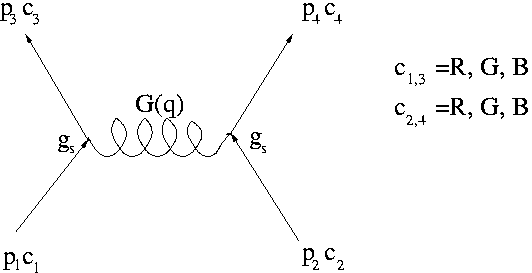As a second example quark-quark scattering is discussed.
The corresponding Feynman diagram is depicted in


In contrast to the quark-antiquark case, here one needs to consider the direct product of a colour triplet and a another colour triplet. The result is the direct sum of a colour sextet and a colour anti-triplet:

There are again two possibilities for CF. One finds
CF(sextet)=+1/3
CF(antitriplet)=-2/3
As a consequence, the quark-quark scattering potential at short distances is attractive in the anti-triplet configuration and repulsive in the sextet configuration. When a third quark is added the direct product of this anti-triplet with the added colour triplet leads to an octect and a colour singlet. The direct product of the sextet with the triplet results in a decuplet and an octet.
The net effect in the decuplet is a repulsive force whereas in the singlet configuration the force is attractive and more attractive than in the octet configuration.